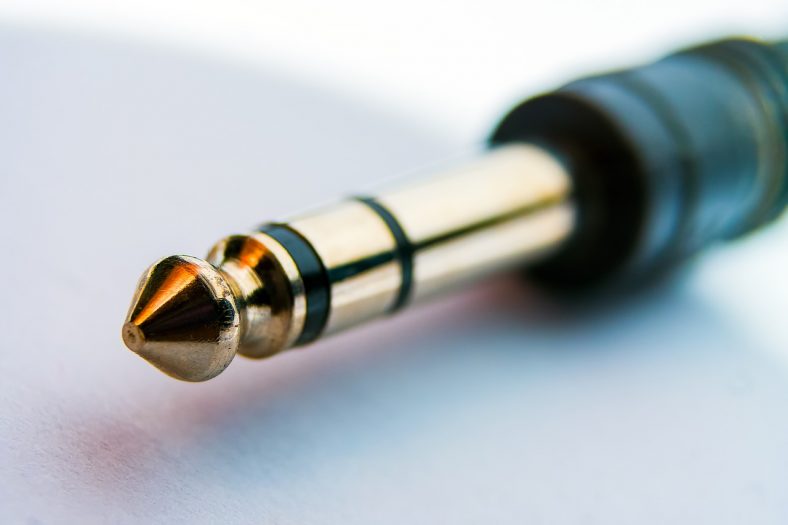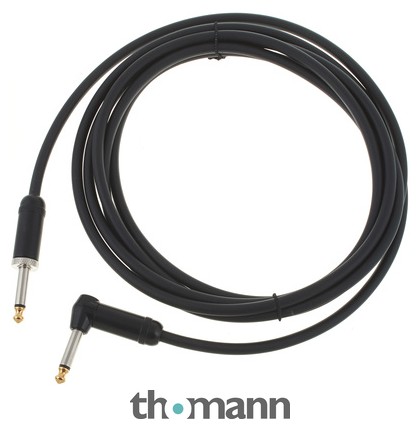The 7 Best Guitar Cables for Sound Quality (2024)

Whether you are casually playing your guitar, recording in your home studio, or performing live to an audience, a high-quality cable is necessary for optimal sound quality. There are many great options on the market to save you from trouble.
A good guitar cable can make all the difference when it comes to sound quality. It is important to select the right cable for your needs in order to get the best possible sound.
My top recommended cable is the Mogami Gold Series, the industry-standard guitar cable used by most professional studios, thanks to innovative technologies that kill unwanted noise.
If you want to go with a more affordable guitar cable, you should check out the Fender Performance Series, which features the highest value for the price range.
Contents
- The 7 Best Guitar Cables for Sound Quality (2024)
- 1. Mogami Gold Series
- 2. Fender Performance Series
- 3. Ernie Ball
- 4. D'Addario American Stage
- 5. GLS Audio
- 6. Spectraflex Original Series
- 7. George L's 155 Gauge
- How does a Guitar Cable work?
- Does a good Guitar Cable make a difference in sound?
- What is the difference between Balanced and Unbalanced Guitar Cables?
- What are the types of cable connectors?
- What are the best Guitar Cables?
- What to look for in a Guitar Cable when buying?
- What is the best way to wrap and store a Guitar Cable?
- Verdict
The 7 Best Guitar Cables for Sound Quality (2024)
Let’s compare these in more detail.
1. Mogami Gold Series
Mogami is one of the first brands to come to mind when talking about high-quality guitar cable. Their Gold Series is regularly used by professional music and broadcasting studios, thanks to its innovative design, killing any unwanted noise in the signal.
Pros
- Great build quality
- Ultra-low capacitance level
- Low noise
- Different length options
Cons
- A bit pricey
The cable features innovative technology with an ultra-high density (UHD) spiral shield and conductive polymer sub-shield to silence any unwanted noise in the signal. Plus, a carbon-impregnated PVC is used as the insulation material to stop handling noise which is excellent for musicians who like to move.
The cable comes in different lengths with 3, 6, 10, 18, and 25 feet and straight-straight, angled-angled, as well as straight-angled options. Although there is no difference between nickel, silver, and gold-plated cables in terms of tone and conductivity, gold has slightly more corrosion resistance and has a longer lifespan without tarnishing. The gear is, of course, more pricey for this reason.
| Length | 3, 6, 10, 18, 25 feet |
| Connector Type | 1/4″ TS Male, Straight-Straight, Straight-Angled |
| Insulation Material | Carbon-impregnated PVC |
| Capacitance Level | 130pF/m |
Mogami Gold Series is the choice of professionals for the top-grade guitar cable with a clear signal that preserves your tone. If spending a few bucks more is not a problem for your budget, this is the top-quality cable around, and the company promises a lifetime warranty.
2. Fender Performance Series
Fender is one of the most trusted names in guitars, amps, and accessories. Their Performance Series guitar cable continues to deliver the quality, this time for an affordable price. The cables are equipped with a PVC jacket, 90% copper shield, metal connectors, and strain relief.
Pros
- Low capacitance level
- Flexible construction
- Great value for its price
Cons
- Might not last quite as long as the premium cables on this list.
There are 5, 10, 15, 18, 25 feet options in the series, with 10 and 18 feet versions featuring a straight to angled connector type option while the rest comes in straight to straight design. The cables have a low capacitance level delivering clear and high-quality tones with a minimum noise level.
The PVC design is quite flexible, which is excellent for preventing twists and tangles. The only drawback is that there are some reports from users that the cables don’t last long; however, this depends on how well they are used.
| Length | 5, 10, 15, 18, 25 feet |
| Connector Type | 1/4″ TS Male, Straight-Straight and Straight- Angled |
| Insulation Material | PVC |
| Capacitance Level | 67pF/m |
Fender Performance Series is the ideal choice if you are after a reliable and decent quality guitar cable with a great value-for-price ratio.
3. Ernie Ball
Ernie Ball is one of the most reliable guitar accessory brands, and their braided guitar cable series is one of the favorites of guitarists. The braided cable is highly flexible and prevents tangles and twists, increasing the life and durability of the cables, while the dual conductor system provides “crisp highs, tight mids, and rich harmonics,” according to the manufacturer.
Pros
- Braided, anti-tangle design
- Looks great and have many color options
- Dual-conductor system
- Great value for the price
Cons
- No options shorter than 10 feet
- Only straight-angled option
There are tons of color options in the series, all great-looking. There are 10, 18, and 25 feet options with straight to angled connectors. The lack of straight to straight and any length shorter than 10 feet might be frustrating for some users, making the series quite limited.
The cable is made of 99.95% oxygen-free copper for rust prevention and heavy-duty metal connectors made from gold or nickel for signal transfer.
| Length | 10, 18, 25 feet |
| Connector Type | 1/4″ TS Male, Straight-Angled |
| Insulation Material | PVC |
| Capacitance Level | 90pF/m |
Overall, if you are looking for a durable, good-quality, and portable guitar cable to carry around, the Ernie Ball Braided series is a great choice.
4. D'Addario American Stage
D’Addario Planet Waves American Stage Cable is one of the most popular guitar jack cables as they can be found in almost every music shop. The shining stars of these cables are the Geo-Tip plugs, which feature a longer shield and slightly flattened tip for enhanced connection.
Pros
- Highly affordable
- Different connector options with Geo-Tip plug
- Low capacitance
- Durable
Cons
- Not very flexible
- No options shorter than 10 feet
With 100% shielded coverage, 95% tinned copper braiding, and low capacitance levels, the cables ensure no handling noise in the signal. Furthermore, they are made in the U.S.A. with durable and high-quality construction. The cable has a 22 AWG oxygen-free copper conductor for high-quality signal transfer.
There are 10 to 30 feet length options and all straight and angled connector type combinations in the series. So, there is a cable for every need. The drawbacks are the lack of flexibility, which leads to tangling issues, and the lack of a short cable option for the pedals connection.
| Length | 10, 15, 20, 30 feet |
| Connector Type | 1/4″ TS Male, Straight-Straight, Straight-Angled, Angled-Angled |
| Insulation Material | Polyethylene |
| Capacitance Level | 92pF/m |
In short, D’Addario American Stage is a durable and affordable guitar cable especially for stage use, thanks to the HelioFused soldering providing a 180-degree inline connection.
5. GLS Audio
GLS Audio offers a great and affordable guitar cable with a vintage-looking Braided tweed cloth jacket. The cable shines with its looks as well as its performance. The double-shield and low capacitance make the signal quiet enough to preserve your tone.
Pros
- Low capacitance
- Clear tone
- Flexible
- Affordable
Cons
- May twist due to the cloth jacket
The cable comes in 6, 10, 15, 20 feet options with a straight to straight or straight to angled design. The braided cloth jacket makes the cable quite flexible to prevent tangles, but it also makes it susceptible to twisting after extended use.
This is pretty adaptable when the braided tweed cloth jacket and the price are considered.
| Length | 6, 10, 15, 20 Feet |
| Connector Type | 1/4″ TS Male, Straight-Straight, Straight-Angled, |
| Insulation Material | PVC |
| Capacitance Level | 125pF/m |
If you are a vintage enthusiast looking for a guitar cable to preserve your tone with a clear sound without any noise, you should check out the GLS Audio tweed guitar cable. It looks genuinely excellent with the black and yellow color options.
6. Spectraflex Original Series
Spectraflex Original Series is one of the relatively higher-end guitar cables on the market. With the great Neutrik plugs and 20 AWG ultra-pure copper center conductors, these cables sound highly transparent and rugged enough to last you long.
Pros
- Great Neutrik plugs
- 20 AWG ultra-pure copper center conductor
- Many color options
- Rugged construction
Cons
- A bit pricey
Another significant aspect of this cable series is that it offers a wide variety of color and pattern options for everyone’s liking. While there are 6, 10, 14, 18, 21 feet length options, there are also designs with straight to straight or straight to angled connector types.
The cable also has a low capacitance level, extended frequency response, and low handling noise for the best sound quality possible.
| Length | 6, 10, 14, 18, 21 Feet |
| Connector Type | 1/4″ TS Male, Straight-Straight, Straight-Angled |
| Insulation Material | PVC |
| Capacitance Level | 130 pF/m |
There is nothing much to say against this cable series, except that they are slightly on the higher-end side in terms of price. But, if you have a bit of extra budget for it, they perform great and look lovely.
7. George L's 155 Gauge
George Lewis is an icon when it comes to guitar cables. He is famous for his 0.155 solderless cable design, which many guitarists prefer to customize and build their own cables using it. These cables feature ultra-low capacitance and great frequency response for providing as transparent sound as possible.
Pros
- Ultra-Low Capacitance
- Clear and pure sound
- Lightweight yet durable design
Cons
- Pricey
- No options shorter than 10 feet
The design of these cables is ultra-thin with a low diameter, yet they are highly durable. The thin design makes them very portable and gives them a vintage look. Plus, the red jacket shield looks pretty good and is easy to find.
| Length | 10, 15, 20 Feet |
| Connector Type | 1/4″ TS Male, Straight-Straight, Straight-Angled |
| Insulation Material | Polyurethane |
| Capacitance Level | 67pF/m |
George L’s 155 Gauge is a professional-level guitar cable with excellent sound quality as pure as possible. It is a bit pricey, but this is a perfect choice if you are after a professional product.
How does a Guitar Cable work?
A guitar cable consists of copper wires with dielectric insulators and a plastic shield. The wires carry the guitar’s audio signals to the amplifier or the recording device, while the shields prevent all electromagnetic interference from surroundings to keep the audio signal pure.
The insulator is there to separate the wires from the shields. The outer jacket also protects the wires, shields, and insulators from external conditions like impact, moisture, and toxic chemicals. All of the components, especially the shield and the insulators, affect the tone of your instrument. Final note; instead of copper, gold, silver, and platinum wires are also used.
Does a good Guitar Cable make a difference in sound?
Guitar cables do affect the sound. As cables act as capacitors, they have capacitance levels that roll off the high-frequencies from the tone. The capacitance levels depend on the length and the quality of the cable. An ideal cable has the lowest capacitance, which would not color the tone much.
This does not mean that top-quality, expensive guitar cables have the best sound. The best sounding cable is the cable without any sound at all, which can be provided by the insulation material with the lowest capacitance possible.
Also, the longer the cable is, the more capacitance you will experience, so you should try to go for the optimum length. You can check the capacitance levels of the cables when purchasing.
What is the difference between Balanced and Unbalanced Guitar Cables?
Unbalanced guitar cables are designed to deliver weak signals from the audio source to an amp, where the audio signals are boosted. They feature a basic conductor wire and a ground wire. The balanced cables are designed to carry strong signals, as they have two-conductor wires and a ground wire.
Guitar cables are mainly unbalanced cables as guitars send weak mono audio signals to the amp, where it gets boosted to be strong enough and hearable. Unbalanced cables can deliver stereo signals as they have two wires. These cables are mainly used with microphones and speakers.
What are the types of cable connectors?
There are two types of cables: balanced cables and unbalanced cables. Balanced cables come in TRS and XLR type connectors, while unbalanced cables have TS or RCA type connectors.
TS or Tip Sleeve cables are the standard cables with ¼ inch connectors. They are unbalanced and mono. RCA or Radio Corporation of America is the mini-jack plug that mainly comes in red and white connectors. They are also unbalanced cables and are prone to buzzing when used with guitar.
The most common balanced cable types are TRS and XLR. They are mainly used as speaker cables and are balanced cables with stereo signals.
What are the best Guitar Cables?
Some of the best guitar cables are Mogami Gold Series, Planet Waves American Stage, and George L’s 155. These cables feature low capacitance levels along with quality material like conductive PVC braided or electrostatic shields, great connectors, linear or oxygen-free copper core.
The most important aspect is the capacitance levels per meter in terms of sound. The reliable brands put these levels on the specs of the cable. If it is not there, you can be suspicious of that brand.
What to look for in a Guitar Cable when buying?
When buying a guitar cable, you should look for capacitance level per meter, flexibility, length, connector types, and price. An ideal guitar cable would have a low capacitance level, a flexible outer jacket, the optimal length for your use, and a high-quality connector suitable to your instrument.
Capacitance Level
The capacitance level should be as low as possible for the best sound quality. As the capacitance level is related to the insulation material, you should ideally go for polyethylene as the insulation material, which is known for its low capacitance level rating compared to rubber.
Flexibility
As the instrument cables are carried around and used often, higher flexibility will extend the life of the cable.
Length
The longer the cable is, the more noise it will produce. So, going for a short cable will provide the optimal sound quality.
Connectors
The connector type is also important, as the straight and the right-angle connector types are suitable for different instruments. You should try them on your guitar to choose the most suitable one.
Also, keep in mind that gold, silver, platinum, and nickel connectors do not have different sound qualities. The gold and platinum ones only have a slightly longer life.
Price
Maybe, the most critical aspect of the guitar cables is the price. Expensive guitar cables do not sound better; rather than the price, look for the necessary specs to find the best guitar cable possible.
What is the best way to wrap and store a Guitar Cable?
The best way to wrap and store a guitar cable is using the “roadie wrap” technique. Hold the cable from the connector and the cable with both hands shoulder-width apart while twisting one side away from you. Then, bring your hands together while the cable creates a loop. Repeat the process.
It is easier to show you than to explain, so here is a video of the technique:
Verdict
Although guitar cables may seem boring and unnecessary, they are one of the most critical elements affecting your tone. You should use a high-quality cable to get the most from your instrument and amp for the highest sound quality.
My top recommended cable is the Mogami Gold Series, the industry standard for most professional studios today.
For tighter budgets, I recommend the Fender Performance Series, the best guitar cable in its price range with high-quality parts and low capacitance levels.













I prefer to use Shielded Twisted Pair cables rather than Coax designs as they are much more reliable, preserve my tone more effectively, save me money (I’m not replacing broken cables regularly), stay noiseless and help save the planet as they are repairable. I have one that is 12 years old and performs as new despite heavy use and abuse. These excellent leads are Chord Company Cream Cable which are made in England by people who actually like music. Cream is a reliable, top tone tool! I hope this is useful to players everywhere.